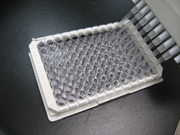Intracellular Nitric Oxide Assay

- Direct, rapid quantitation of intracellular nitric oxide in cultured cells
- Detects nitric oxide as low as 3 nM
- Fluorometric probe is nitric oxide-specific and has excellent photostability and pH stability
- Suitable for flow cytometry, fluorescent microscopy, and fluorometric microplate detection